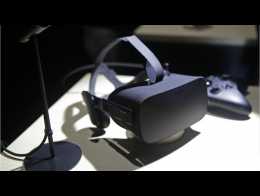
With three VR headsets in one year: Oculus Rift, PlayStation VR and HTC Vive, we discuss the differences and which is best for you
After the rush of launches in 2016, 2017 has been a year of consolidation for the VR industry. We’ve had price cuts for all the major players, new software and, in some cases, new hardware goodies.
The main contenders for virtual supremacy, however, remain the same. We have the trailblazing Oculus Rift, the space-detecting, “room-scale” HTC Vive, and the PS4-compatible PlayStation VR. Various technical differences mean they all have their ups and downs but which is the one for you? Read on to find out.
Oculus Rift
It makes sense to start with the Oculus Rift, as without Palmer Luckey’s initial makeshift VR efforts we probably wouldn’t be where we are today with VR. Oculus Rift has been the poster boy for VR, with a name that sounds cool and hardware that has gone through numerous development kit versions to whet our appetites.
-
video playing

-
15,000 HTC Vive VR Headsets Sold In Under…

-
Sony Drops Price of PlayStation VR Bundle

-
Oculus Rift: New $200 Standalone Wireless VR…

-
HTC Offers Financing For Vive VR Headset

-
THE CLIMB Launch Trailer (Oculus Rift – VR Game)

The result is that the current Rift is technically excellent, with strong support from developers and a dedicated fanbase. Of course, the company has now been bought by Facebook but, to date, we haven’t seen any significant change in strategy or direction as a result.

All that makes it the leading VR headset designed to work with PC hardware. It does require quite a powerful PC though – with a good processor, plenty of RAM and a £250 graphics card as a baseline (details below). No problem if you already have the hardware but many will still require a graphics card upgrade.
Fortunately, now that Facebook has permanently reduced the cost of the Touch bundle to £399 – a price that includes the headset, two Oculus Touch controllers, an Xbox One controller and a remote – the total cost is a little less than it was before, but you’ll still be paying £649. Arguably, though, the card is a worthwhile investment for any gamer anyway.
The headset itself has impressive specifications. A high-resolution OLED panel, with a 110-degree viewing angle, running at 90Hz is at the core. Then there’s all the sensors you’d expect to track head motion, plus an IR-based USB sensor that sits in front of the player to track motion. There’s also the snazzy looking Touch controllers, each of which tracks hand motions plus has an analogue stick, trigger and face buttons.
Read more about Oculus Rift
Like all the headsets here, you have a cable running to your PC or console, so gambolling about isn’t really possible. For all its technical excellence, and lightweight design, the Rift still straps to your head via some pretty simplistic stretchy straps.
With its many iterations in development, Oculus has had a lot of time to build tools to allow developers to get the most out of the headset and there’s a lot of VR experiences already out there. Games include space flight sim Eve Valkyrie and platformer Lucky’s Tale.
By utilising the PC platform Oculus is tapping into a potentially huge market of PC owners. However the kind of gaming hardware required is a tiny subset of that. The biggest PC hits are often those that allow play on even modest hardware, often with little upfront cost – you can’t get much further from free-to-play than a £400 headset. PC gamers often spend months or years playing the same competitive games ad infinitum, totting up huge numbers of hours, and nothing on Rift yet will tap into that kind of compulsive, community play.
And then there are the big players in the market. Steam has its huge customer base, many of whom don’t go elsewhere to buy games and might find Oculus’s own software store a big mental leap. Then there’s the likes of Blizzard, who has yet to show any inclination to move to VR, but without which any PC-based platform will have to compete for time.
HTC Vive
HTC’s entrance into the world of virtual reality came as something of a surprise. With no gaming pedigree, the company’s headset could easily have been dismissed as a ‘me too’ project. However, its slick hardware, impressive location tracking and partnership with gaming behemoth Valve immediately propelled it into the limelight.
While Oculus took its precious time with Rift, the Vive’s gestation has been far quicker. But HTC Vive is very similar in many ways to its main competitor, albeit more expensive. Where the Oculus Rift Touch bundle can be picked up for £399 now, an HTC Vive package will set you back £600, with the two controllers, headset and room sensors.
Relying on top-end PC hardware to power it, the Vive has the same basic specifications as the Oculus Rift – a 90Hz, 2,160×1,200 OLED display with 110-degree viewing angle.
As a phone manufacturer, HTC has plenty of experience with sensors and there’s the usual collection of accelerometers and gyroscopes here. However, the Vive also includes an impressive laser tracking system, which lets you rig up external sensors to track your motions around a small-room sized area. Of course, such a feature requires software support from developers and you have to factor the extra cost in as well, plus you’re still cabled to your PC of course. The same sensors also detect the wand-like controllers’ motions in space.
Read more about HTC Vive
With similar hardware and a headset also aimed at PC gamers, the HTC Vive goes head-to-head with Oculus Rift, but it has one key advantage: official support for SteamVR.
While SteamVR isn’t an open platform (though there is an open version called OpenVR), it ties PC gamers to using a store that they already know and largely love. For a company that’s primarily a retailer these days, Valve engenders incredible goodwill amongst the gaming community.
The HTC Vive is the most advanced VR headset of the lot right now, straight out of the box, but with HTC’s recent troubles, it’s probably worth holding fire on buying one right now. With the company’s future uncertain, this is one VR platform you don’t want to be committing to right now.
PlayStation VR
And now for something completely different. The Oculus Rift and HTC Vive do have their differences, but both are fighting over essentially the same market: gamers who most-likely already own high-end PC rigs.
Sony is instead targeting the approximately 35m gamers worldwide who own a PS4 console. The headset was launched in October 2016 at a reasonable £350, which Sony has effectively reduced recently by including the required camera for the same original price of £350. Add a pair of Move controllers and the price rises to £399.
It’s hard to say just how strong a play Sony’s is, even now a year after its launch. If you were to make a shortlist five years ago of companies you thought could deliver a good VR gaming experience, Sony would almost certainly be on it, while its main competitors either wouldn’t get a second thought or barely existed. Compare them to the huge brand power of PlayStation and you’d think it would be a done deal.
Read more about PlayStation VR
Sony’s advantage is also its potential downfall though. While the PlayStation 4 is powerful enough to produce compelling VR experiences at the kind of frame rates and detail levels required in order to make them comfortable to play, it’s undeniable that the console isn’t as powerful as the recommended PC specs for the Oculus Rift and that limits the graphical fidelity and detail in games.
The headset’s resolution is lower than its competitors at 1,920 x 1,080. That might be to keep prices down or ease the processing burden on the PS4. It may also be because with PlayStation VR, the console outputs to both the headset and your TV at the same time, so others can see what’s going on, and potentially allowing for co-op gameplay experiences. Sony understands the living room and family dynamics and this kind of feature proves that.
Sony has given the design of the headset a lot more thought than most as well. It looks far cooler than the still prototype appearance of the others. The doughnut shape sits on top of your head, with the weight sitting downwards, like a hat, with the screen just sitting lightly on your face. It’s a big improvement over the strapped to your face feel of Rift and Vive.
There’s also a bonus in that Sony’s long-running Move controllers are perfect for many VR experiences, while the DualShock controller is so familiar to PlayStation gamers that they’ll only need get their head around one new bit of kit, rather than two or more.

Then there’s Sony’s trump card, its long-running relationship with software developers and it’s own internal studios. When it comes to creating great software experiences, Sony is up there with the best, though I’d love to see what Nintendo could do with VR too.
With the PlayStation 4 being such a huge success, if anyone could bring VR gaming to the masses then it’s Sony. It may not have the best specifications, but the design is top-notch and you know it’ll just work when you plug it in.
Conclusion
We’ve talked a lot about games here, but what about other types of VR experience, such as 360-degree videos and photos? Well those are great and we’ve loved them on headsets such as Google’s Daydream View and Samsung Gear VR but I don’t see anyone buying an expensive headset like these for anything but gaming and gaming-like experiences, at first.
After all that discussion, our advice is the same as it was this time last year: wait. These current headsets, though great, are still first generation devices, and will likely be trumped both in terms of hardware capabilities and software support in the next year or so.
We already know a new PlayStation VR and Oculus Rift are in the pipeline, and Facebook seems to have fully committed to VR with the announcement recently of the all-in-one Oculus Go as well.
If you absolutely must buy a VR headset this year and own both a PC and a PS4 then I’d err towards PlayStation VR as being the superior, hassle-free experience, and one that you can show off to others. If you absolutely must have the best possible graphics performance, don’t care about playing with others and like tinkering with hardware then your best bet, with HTC’s future uncertain right now, is the Oculus Rift.
[“Source-expertreviews”]










